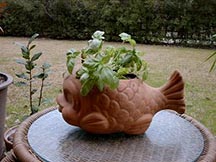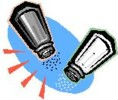Make the most of culinary herbs and spices.
Other articles you might enjoy:
1. An Herb Gardener's Diary--Part Two
2. What's the Buzz About Bees?
An Herb Gardener's Diary
by Sandra Bowens
Most gardens begin in the dark of winter as a dream of spring. I envisioned pots of fragrant herbs (and vegetables) littering my patio as they beckoned me to take a few cuttings and try new recipes. Since I couldn't get my hands into the dirt just then, I dove into researching how to go about it later.
Learning and Planning
The Internet is a logical place to begin any research project. I gleaned information about growing herbs in general along with finding places to order catalogs or answer specific questions.
It's important to take your location into account. I live in the southern United States where people garden nearly year around so I wanted to learn more about growing herbs in my climate. As luck would have it, I saw an announcement for a lecture on "Herb Gardening in Louisiana" to be held at my nearby library.
Presented by a Master Gardener from the local cooperative extension office, the talk offered a wealth of information about which plants do or don't do well in this area plus hints about how to grow and harvest them. A handy reference guide was free. Best of all, I learned which garden shops and nurseries were preferred by the other gardeners attending the lecture.
Books, of course, are an excellent source of research for gardening so I picked up a few of those from library, too. One book, Month-by-Month Gardening in Louisiana, written by expert Dan Gill, has proven to be an invaluable purchase.
Armed with all this information about growing herbs, I settled into planning my garden.
I chose a container garden because it seemed like a less time-consuming way to begin. I wouldn't have to dig up my yard, amend the soil with compost or worry about a late freeze. I also wanted to start on a small-scale and this is a way to limit myself. Containers do dry out more quickly so I will have to stay on top of watering more than I would with planting beds.
At the suggestion of one book, I started a notebook to keep my gardening plans and records. Here I listed the herbs I wanted to grow: dill, oregano, sage, thyme, bay, arugula, marjoram and parsley--all favorites that I cook with frequently.
The Master Gardener had suggested that newbies start with one herb pot. Who on Earth could actually do that? Certainly not me, the ambitious new gardener!
Planting
In late January I planted small pots of arugula, dill, marjoram, sage and parsley seeds. I sowed them directly into potting soil, which could be considered a no-no. I knew I should use a seed-starting medium but I didn't have any and I was too enthusiastic. They began to sprout anyway.
I arranged the pots in a tray that I could move around easily. During the day I sat the tray in the sunshine and, if necessary because of cool temperatures, moved it indoors at night. Before long all the seeds had sprouted.
Meanwhile, a pot of arugula from last season came back to life. I decided that this plant was easy enough to grow that I didn't need my new seedlings so I gave them away. My friends were delighted to receive the little peat pots of sprouts. If you are going to plant seeds, consider sowing extra to give away. It will make you feel good and your friends happy.
Growing herbs from seeds is difficult they say. You might want to skip this step and purchase small plants that are already established.
Sprouting
The best part of planting seeds, however, is the delight you experience when you finally find a green sprout poking out of the dirt you have been checking every day for the last week. And then more poke out, and more, until finally you are faced with the brutal process of "thinning."
Thinning is painfully pulling up all the precious little sprouts except for the chosen few that are spaced at proper intervals. Just keep reminding yourself it's for the good of the future herb. Overcrowding is a bad thing for the root system and the plant needs air circulation. I have made a mental note to plant fewer seeds per pot in the future.
Although I have had good luck with my original four plants started directly into potting soil, I did finally get around to buying a seed starting soil mix. It's much lighter and enriched with more nitrogen to give plants a good start. I used it to start a thyme plant. As I thinned the thyme seeds, I thought they seemed much more vigorous than the others had been so I'm sure this is the way to go in the future.
Tips
In the beginning stages of planning and starting an herb garden many factors come into play. I've come across a few helpful hints to help you begin.
1. Herbs need at least 6-8 hours of sunlight per day. Choose your location wisely.
2. Be very careful not to let your planted seeds or seedlings dry out.
3. Try to find information about growing plants specific to your area.
4. Pay close attention to the instructions for planting depth, temperature requirements and other details on seed packets.
It's been an exciting couple of months with my little herb plants. I encourage you to try your thumb at planting. To share your own experiences with other aPinchof.com website readers, write to us.
Here's one that's full of our favorite recipes because we wrote the book! It is also full of information, helpful hints and ideas for using herbs and spices in your kitchen.

A handy and highly-recommended reference for growing herbs, vegetables and edible flowers on your deck or patio. See aPinchOf.com's review of this book.
Here are the answers to all of your questions arranged season by season. Fully illustrated, this growing guide covers 64 different herbs.




